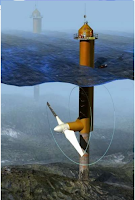The tidal power also called tidal energy is a form of hydropower which converts the energy of ocean tides into the useful form of power mainly electricity. We have already discussed how the tides are formed in the article wave energy generators. Let us refresh that again here, Tides cause changes in the depth of the ocean, this cyclic occurrence of rising and falling of the water surface happen due to the gravitational pull of the moon. The rising and falling of the water level (Tides) create the kinetic energy that is used to run the turbine to generate the electricity. This has the potential of generating a large amount of electricity or can be used on a smaller scale. There are many places around the world who have implemented pilot projects of different types of tidal energy generators. In this article, we are going to discuss different types of tidal energy generation methods.
Tidal Energy Generation Methods
- Tidal Stream Generator
- Tidal Barrage
- Dynamic Tidal Power
- Tidal Lagoon
Tidal Stream Generator
TSG uses the kinetic energy of moving water to give power to the turbines in the way similar to the wind turbine to generate electricity. This type of tidal power generation is the cheapest as well as environment-friendly. Due to the higher density of water, the power available in TSG in a given area is greater than a wind turbine. The density of water is higher than air so the TSG can be smaller than the wind turbine for the same output. This can be enhanced by using the Venturi effect, which means that the TSG should be planned and positioned to get water move faster through the turbine.
Tidal Barrage
Tidal Barrages utilize potential energy to rotate the turbine. It is typically a dam kind of structure built across in the bay. The structure consists of turbines, sluice gates, and ship locks. Sluice gates are used to open and close regularly to control the flow of water and it helps to maximize the power generation. The sluice gates remain in open position during high tide and closed during low tide to create the potential difference in the water levels to power the turbine accordingly.
Dynamic Tidal Power
This type of power plant is designed to generate electricity from the kinetics of tidal water. Long dam of at least 30 to 60 km perpendicular to the water movement interacts with the tidal flow to create the hydraulic head. A barrier parallels to the coastline at the far end of the dam, giving it a T-shape, amplifies the head on either side of the structure. This hydraulic head, together with the shape of the tunnels, results in the acceleration of water that drives the many turbines in the dam to generate electricity.
Tidal Lagoon
It is a tidal energy capture structure constructed as a circular retaining wall which is arranged with turbines to utilize potential energy of tides. A tidal lagoon is used to generate electricity from the natural rise and fall of the tides. When the tides come in contact which is held back by turbine wicket gates. Wicket gates are used to control the flow through the turbine and can be completely closed to stop water from entering the lagoon. By this way, this creates a difference in water height (head) between the sea and inside of the lagoon. Once it is attained the proper head, the wicket gates are opened and water enters through the mounted turbines forecely to rotate the turbine to generate electricity. Then the water in the lagoon returns back to the sea when tides flow out (ebbs). Since the turbine is bi-directional, we can generate electricity during the return of the tides as well.




Comments
Post a Comment